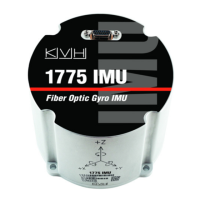This document contains proprietary information of KVH Industries, Inc. and neither this document nor said proprietary information shall be
published, reproduced, copied, disclosed, or used for any purpose without the express written permission of a duly authorized KVH
representative.
7 Commands and Queries
All commands and their responses are terminated with either one or both of the ASCII codes
for a carriage return (often symbolized as <CR> or ‘\r’ and ASCII code 0x0D) or a line feed
(<LF> or ‘\n’ and ASCII code 0x0A). Command and response parameters are delimited using
the comma character (‘,’, ASCII code 0x2C).
Input commands are case-insensitive. Responses to commands will be in all upper case
(capital letters) unless otherwise indicated.
All commands are prefixed with either the ‘?’ or the ‘=’ character. The ‘?’ character indicates
that the command is a query (a request for data). The ‘=’ character indicates a command and
the unit will perform an action.
All commands have responses unless otherwise indicated. By default, commands to the unit
will generate a response that is identical to the command itself, except that the ‘=’ prefix
character will not be transmitted in the response. By default, queries to the unit will receive a
response that is lacking the ‘?’ prefix character, has the full text of the command, and then
provides the answer to the query, allowing ease of automation and a positive feedback
mechanism for anyone manually entering commands. Deviations from this default are
described in the subsections below.
Invalid commands are ignored in Normal Mode. When in Configuration Mode, unknown or
unaccepted input commands will result in a response message starting with the word
“INVALID,” followed by an echo of the string received by the IMU.
Invalid input parameters (e.g., out of range value, unexpected numeric argument, etc.) to a
recognized command keyword will result in a prompt for the user starting with the keyword
“USAGE” followed by a description of how to use the command or with the keyword “ERROR”
with a brief description. These responses are intended for a human reader, not for an
automated system. Automated systems that detect a USAGE or ERROR response may need
to request operator assistance due to a likely communications problem (e.g., incorrect
programming, intermittent cable connection, cable crosstalk, etc., or simply retry the
command).
The users should not rely on future preservation of existing responses or observed behavior to
undefined commands or out of range parameters since the behavior may change in future
firmware versions.
Most commands will result in parameters being stored in non-volatile memory and recalled on
the next reset/power-on. Exceptions will be described in the command descriptions below.
Command defaults can be restored by command or by an input signal to the interface.

